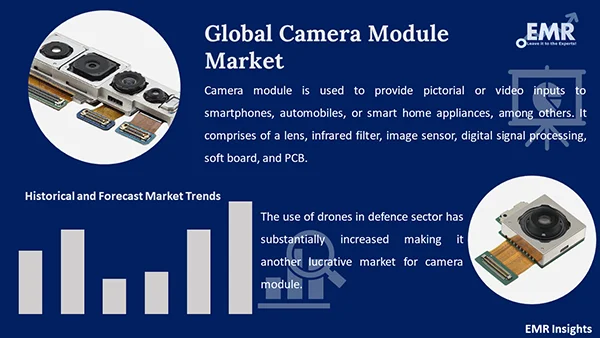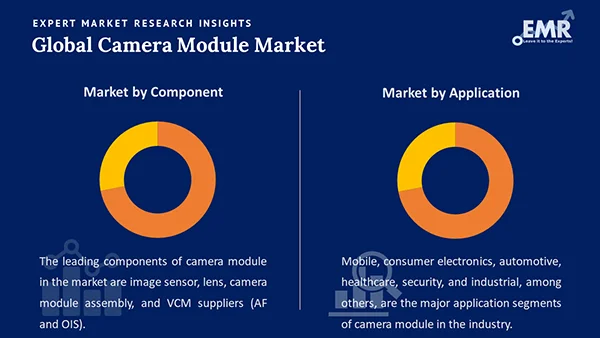
Consumer Insights
Uncover trends and behaviors shaping consumer choices today
Procurement Insights
Optimize your sourcing strategy with key market data
Industry Stats
Stay ahead with the latest trends and market analysis.
The global camera module market attained a value of around USD 46.59 Billion in 2025. The market is further expected to grow at a CAGR of nearly 7.80% in the forecast period of 2026-2035 to reach a value of around USD 98.74 Billion by 2035.
Base Year
Historical Period
Forecast Period
Compound Annual Growth Rate
7.8%
Value in USD Billion
2026-2035
*this image is indicative*
Manufacturers of camera modules are concentrated in China, Japan, South Korea, among other countries. The camera module industry has witnessed a spike in the number of manufacturers in the domestic market of China due to the low manufacturing technicalities. However, with increased market competition, the price war has intensified.

Read more about this report - REQUEST FREE SAMPLE COPY IN PDF
In the coming years, competition to introduce new and advanced versions with greater resolution and smaller size is expected to raise the entry threshold of the market. As the application and desirability of smart technology penetrates the developing markets, the demand for camera modules is expected to witness a healthy growth. Aerospace, automotive, pharmaceutical, consumer service, and robotics, among other industrial fields, together pose a lucrative market for camera modules globally.

Read more about this report - REQUEST FREE SAMPLE COPY IN PDF
Camera module is used to provide pictorial or video inputs to smartphones, automobiles, or smart home appliances, among others. It comprises of a lens, infrared filter, image sensor, digital signal processing, soft board, and PCB. When light passes through the lens, the IR filter eliminates the unnecessary light projected on the sensor and then converts it into a digital signal through an internally integrated digital signal processing (DSP).
Market Breakup by Component
Market Breakup by Application
Market Breakup by Region
The increased penetration of smartphones, tablets, and smart home appliances and the rising popularity of automated and semi-automated cars, among other developments and innovations in smart technology, are strengthening the demand for camera modules with high resolution and miniaturisation. Its usefulness as a video input device helps complete tasks like ID card identification, facial recognition, and fingerprint collection, among others, which is further projected to aid the market growth. Smart Security monitoring systems are vital in commercial, residential, and industrial spaces and they are witnessing a strong demand. This is giving a further impetus to the market growth for compact camera modules. The extensive use of document scanners in workspaces is also propelling the growth of the camera module market. Additionally, the use of drones in defence sector has substantially increased making it another lucrative market for camera module. Moreover, camera modules help provide 3D animated simulation in real-time, which makes it convenient to visualize and understand the work dynamics of a project conveniently and communicate ideas better, further intensifying its demand in aerospace, automotive, and engineering fields, among others.
The report presents a detailed analysis of the following key players in the camera module market, looking into their capacity, market shares, and latest developments like capacity expansions, plant turnarounds, and mergers and acquisitions:
The comprehensive EMR report provides an in-depth assessment of the market based on the Porter's five forces model along with giving a SWOT analysis.




*While we strive to always give you current and accurate information, the numbers depicted on the website are indicative and may differ from the actual numbers in the main report. At Expert Market Research, we aim to bring you the latest insights and trends in the market. Using our analyses and forecasts, stakeholders can understand the market dynamics, navigate challenges, and capitalize on opportunities to make data-driven strategic decisions.*
Get in touch with us for a customized solution tailored to your unique requirements and save upto 35%!
The global camera module market accounted for about USD 46.59 Billion in 2025.
The market is projected to grow at a CAGR of nearly 7.80% in the forecast period of 2026-2035.
The market is estimated to witness a healthy growth in the forecast period of 2026-2035 to reach USD 98.74 Billion by 2035.
The major drivers of the market include the increased applications of camera modules in various end use industries and the electrification of the automotive industry.
The key trends of the market include new developments and innovations in lens and sensors. and advancements in smart technology.
The major markets are North America, Europe, the Asia Pacific, Latin America, and the Middle East and Africa.
The leading components of camera module in the market are image sensor, lens, camera module assembly, and VCM suppliers (AF and OIS).
Mobile, consumer electronics, automotive, healthcare, security, and industrial, among others, are the major applications of camera module in the market.
The key players in the global camera module market are Sony Corporation, Samsung Electronics Co. Ltd., LG Electronics Inc., OFILM, Chicony Electronics Co., Ltd, and MCNEX Co., Ltd., among others.
Explore our key highlights of the report and gain a concise overview of key findings, trends, and actionable insights that will empower your strategic decisions.
| REPORT FEATURES | DETAILS |
| Base Year | 2025 |
| Historical Period | 2019-2025 |
| Forecast Period | 2026-2035 |
| Scope of the Report |
Historical and Forecast Trends, Industry Drivers and Constraints, Historical and Forecast Market Analysis by Segment:
|
| Breakup by Component |
|
| Breakup by Application |
|
| Breakup by Region |
|
| Market Dynamics |
|
| Competitive Landscape |
|
| Companies Covered |
|
| Report Price and Purchase Option | Explore our purchase options that are best suited to your resources and industry needs. |
| Delivery Format | Delivered as an attached PDF and Excel through email, with an option of receiving an editable PPT, according to the purchase option. |
Datasheet
One User
USD 2,499
USD 2,249
tax inclusive*
Single User License
One User
USD 3,999
USD 3,599
tax inclusive*
Five User License
Five User
USD 4,999
USD 4,249
tax inclusive*
Corporate License
Unlimited Users
USD 5,999
USD 5,099
tax inclusive*
*Please note that the prices mentioned below are starting prices for each bundle type. Kindly contact our team for further details.*
Flash Bundle
Small Business Bundle
Growth Bundle
Enterprise Bundle
*Please note that the prices mentioned below are starting prices for each bundle type. Kindly contact our team for further details.*
Flash Bundle
Number of Reports: 3
20%
tax inclusive*
Small Business Bundle
Number of Reports: 5
25%
tax inclusive*
Growth Bundle
Number of Reports: 8
30%
tax inclusive*
Enterprise Bundle
Number of Reports: 10
35%
tax inclusive*
How To Order

Select License Type
Choose the right license for your needs and access rights.

Click on ‘Buy Now’
Add the report to your cart with one click and proceed to register.

Select Mode of Payment
Choose a payment option for a secure checkout. You will be redirected accordingly.
Gain insights to stay ahead and seize opportunities.

Get insights & trends for a competitive edge.

Track prices with detailed trend reports.

Analyse trade data for supply chain insights.

Leverage cost reports for smart savings

Enhance supply chain with partnerships.

Connect For More Information
Our expert team of analysts will offer full support and resolve any queries regarding the report, before and after the purchase.
Our expert team of analysts will offer full support and resolve any queries regarding the report, before and after the purchase.
We employ meticulous research methods, blending advanced analytics and expert insights to deliver accurate, actionable industry intelligence, staying ahead of competitors.
Our skilled analysts offer unparalleled competitive advantage with detailed insights on current and emerging markets, ensuring your strategic edge.
We offer an in-depth yet simplified presentation of industry insights and analysis to meet your specific requirements effectively.
Share